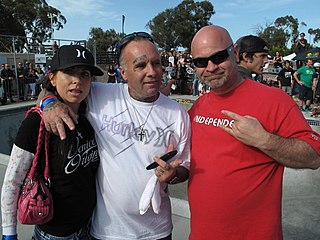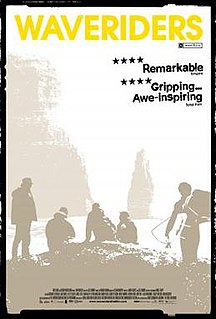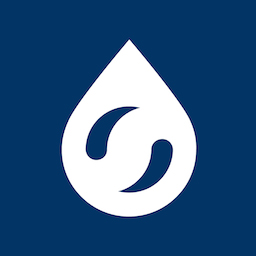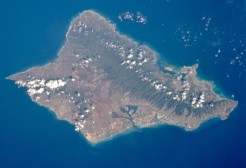
Mavericks is a surfing location in northern California outside Pillar Point Harbor, just north of the town of Half Moon Bay at the village of Princeton-by-the-Sea. After a strong winter storm in the northern Pacific Ocean, waves can routinely crest at over 25 feet (8 m) and top out at over 60 feet (18 m). Routinely, waves that break can be recorded on seismometers. The break is caused by an unusually shaped underwater rock formation.

Laird John Hamilton is an American big-wave surfer, co-inventor of tow-in surfing, and an occasional fashion and action-sports model. He is married to Gabrielle Reece, a professional volleyball player, television personality, and model.

Big wave surfing is a discipline within surfing in which experienced surfers paddle into or are towed onto waves which are at least 20 feet high, on surf boards known as "guns" or towboards. Sizes of the board needed to successfully surf these waves vary by the size of the wave as well as the technique the surfer uses to reach the wave. A larger, longer board allows a rider to paddle fast enough to catch the wave and has the advantage of being more stable, but it also limits maneuverability and surfing speed.

Edward Ryon Makuahanai Aikau was a well-known Hawaiian lifeguard and surfer. As the first lifeguard at Waimea Bay on the island of Oahu, he saved over 500 people and became famous for surfing the big Hawaiian surf, winning several awards including the 1977 Duke Kahanamoku Invitational Surfing Championship.

Tow-in surfing is a surfing technique which uses artificial assistance to allow the surfer to catch faster moving waves than was traditionally possible when paddling by hand. Tow-in surfing was invented by surfers who wanted to catch big waves and break the 30 foot barrier. It has been one of the biggest breakthroughs in surfing history.
Mark Sheldon Foo was a professional surfer. Foo drowned while surfing at Mavericks, Half Moon Bay, California.

Jay J. Adams was an American skateboarder who as a teen, was the youngest member of the Zephyr Competition Skateboarding Team (Z-Boys). His spontaneous freestyle skateboarding style, inspired by ocean surfing, helped innovate and popularize modern skateboarding. His aggressive vertical tricks make him one of skateboarding's most influential stylists. Adams died of a heart attack on August 15, 2014.

Big Wednesday is a 1978 American coming of age film directed by John Milius. Written by Milius and Dennis Aaberg, it is loosely based on their own experiences at Malibu. The picture stars Jan-Michael Vincent, William Katt, and Gary Busey as California surfers facing life and the Vietnam War against the backdrop of their love of surfing.

Surf culture includes the people, language, fashion, and lifestyle surrounding the sport of surfing. The history of surfing began with the ancient Polynesians. That initial culture directly influenced modern surfing, which began to flourish and evolve in the early 20th century, with its popularity spiking during the 1950s and 1960s. It has affected music, fashion, literature, film, art, and youth jargon in popular culture. The number of surfers throughout the world continues to increase as the culture spreads.
Bruce Alan Brown was an American documentary film director, known as an early pioneer of the surf film. He was the father of filmmaker Dana Brown.
Jeff Clark is one of the most noteworthy and respected big-wave surfers, famous for surfing Mavericks alone for 15 years before it was widely discovered by the big-wave surfing community.
Keala Kennelly is a professional surfer, DJ, and actress from Kauai, Hawaii. After spending a decade ranked in the top 10 on the ASP World Championship Tour (WCT), Kennelly took a break from the tour in 2007 to explore her passions for acting and music, including a recurring role as a surfer in the 2007 series John from Cincinnati. She continues to DJ and compete as a big wave surfer.
Terry Wade is an American bodysurfer.

Jack O'Neill was an American businessman, often credited with the invention of the wetsuit, and the founder of the O'Neill brand.

Waveriders is a 2008 documentary film produced by Margo Harkin and directed by Joel Conroy.
Philip Rube "Flippy" Hoffman was a legendary big wave surfing pioneer and businessman.

Surfline is a company and website based in Huntington Beach, California that specializes in surf forecasting and surf reports, live webcasting, photography, videography, as well as editorial coverage of the sport of surfing. Surfline.com is now ranked 1,180 in the US and 5,784 in the world in terms of popularity compared to other websites and is now the largest provider of streaming HD coastal cams. Since 2003 it has taken on buoyweather.com and fishtrack.com (2012), on average the family of websites receives 175,000 visitors per day. The site includes streaming video, surf reports and forecasts. Surfline.com offers streaming cameras at 150 surf breaks, and is one of the larger surf cam websites. Surfline currently has approximately 50 employees.

Surfing in the United States is a popular pastime in coastal areas of the country.
The earliest recorded incidence of women's surfing concerns the mythical Kelea. Kelea was born of royalty in Maui, it is believed she out-surfed riders of both genders. A few centuries years pass until the mid-late 1800s, when Thrum’s Hawaiian Annual reported that women in ancient Hawaii surfed in equal numbers and frequently better than men. Women's surfing in Australia has a popular following amongst female participants.














